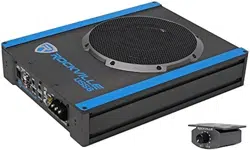Loading ...
Loading ...
Loading ...

Connecting the subwoofer
Before doing any wiring, look through this manual and identify the diagrams to follow for power, input and speaker connections for your
particular installation. Be sure you understand all the connections before you proceed.
1. Connect the ground terminal to the closest point on the chassis of the vehicle. Keep this ground wire to less than 39" (100 cm) in
length. Use 8 gauge (or heavier) wire.
2. Connect the remote terminal to the remote output of the head unit using 16 gauge (or heavier) wire.
3. Connect an empty fuse holder within 18" (45 cm) of the car battery, and run 8 gauge (or heavier) cable from this fuse to the amplifier
location.
4. Check that the fuse holder is empty. Then connect the fuse holder to the "BATT+" connection on the amplifier.
5. Connect all line inputs and outputs (Connect all speakers, following the diagrams in this manual. Be sure to observe proper polarity to
avoid audio phase problems).
6. Insert a 30A fuse into the fuse holder.
7. Check all connections before powering up the subwoofer.
8. Set all level controls to minimum position, and set all crossover controls/switches to the desired frequency points.
9. Power up the head unit and the subwoofer. Then set the volume control on the head unit to about 3/4 volume, and adjust the
subwoofer's input level controls to just below the level of distortion.
Further fine tuning of the various controls may be necessary to obtain best results.
Don't misuse the level control!
Do not mistake the input level control for a volume control! It is designed ONLY to match the output level of your audio source to the
input level of your subwoofer.
Do not adjust this input level to maximum unless your input level requires it.
Ignoring these instructions will result in an input overload to the amplifier in the subwoofer, and excessive audio distortion. It can also
cause the protection circuit to engage.
10.
Loading ...
Loading ...
Loading ...
